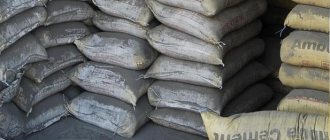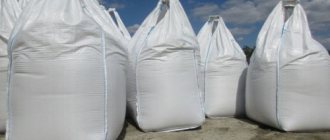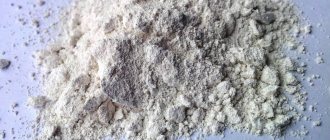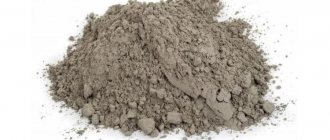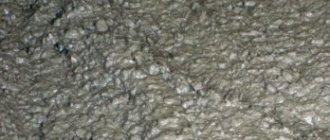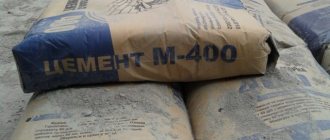Home |Cement |Aluminous cement
Date: January 6, 2019
Comments: 0
One of the most common materials in demand in construction is cement. Of the many known types of cement compositions, aluminous cement stands out, having a number of positive performance characteristics.
Alumina cement is characterized by the ability to rapidly harden in air and under water, providing increased strength characteristics after hardening. The fast-acting composition is used in the production of concrete and special solutions resistant to elevated temperatures.
Aluminous cement is created using a proven method, which involves enriching the initial components with alumina - bauxite, limestone, and rocks with a high concentration of aluminum oxides. After firing the fractions in special ovens, grinding is carried out, after which a mixture is obtained for the preparation of heat-resistant concrete.
Let us consider in detail the varieties, structure, specifics of production, characteristics of the alumina composition, its operational properties, labeling and application.
Cement is one of the most necessary and important materials in construction.
Varieties and structure
Aluminous cement, depending on the concentration of impurities, has the following varieties:
- normal composition, with an alumina concentration not exceeding 66%, and a proportion of silicic acid of about 3%;
- high-alumina material containing about 76% alumina, the concentration of silicic acid reduced to 1%.
The main components that determine the structure of the alumina-based mixture are the oxides of the following chemical elements:
- Aluminum, the concentration of which is from 30 to 50%.
- Calcium, the specific gravity of which corresponds to values from 35% to 45%.
- Iron and silicon, contained in equal percentages, varying from 5 to 15%.
Manufacturing technology
Limestones CaCO3 and bauxites with the general formula Al2O3*nH2O are used as raw materials for the production of GC.
Bauxite is heterogeneous in its composition and contains oxides of aluminum (Al2O3), silicon (SiO2), iron (Fe2O3) and others.
In the production of GC, bauxite is used with a silicon modulus (quality factor), which is calculated as the Al2O3/SiO2% ratio and is at least 2%.
Due to the shortage of bauxite in Russia, bauxite iron ore is used, to which limestone and scrap iron are added. Granulated blast furnace slags are used as clinkers.
The use of these materials as raw materials can significantly reduce the cost of aluminate compositions.
There are two main methods for producing high alumina cement.
At a temperature in special drums, the mixture is melted. Allow the resulting product to cool and grind to a fine powder.
The raw materials are ground to powder and fired in ovens. After the resulting granules have cooled, they are ground into a fine powder.
Attention! The product obtained by melting is an order of magnitude superior in quality to the GC obtained by sintering.
Russian manufacturers of aluminate mixtures mainly produce GC by melting.
Production specifics
Aluminous cement is produced by burning bauxite and limestone using the following methods:
- high-temperature sintering of pre-prepared raw materials. The process is carried out at a temperature of 1.3 thousand degrees Celsius using special shaft or rotary furnaces. The technology is energy intensive and is not widely used. The resulting aluminous cement is characterized by high quality and strength indicators;
Pure limestones and bauxites are used as raw materials
- gradual melting in shaft-type furnaces used for non-ferrous casting, equipped with a water cooling device. The process involves grinding the resulting clinker after it has cooled. Production is carried out from high quality bauxite with the addition of limestone and coke.
The composition is made from rocks with a high content of aluminum oxide, which was the reason for the additional name of the mixture called aluminate.
Features when working with white cement
White cement is an excellent material for implementing original design ideas, finishing work, pouring structures, etc. When working with white M600 cement, you need to remember some important rules that will allow you to achieve maximum results.
Things to remember when working with white cement:
- All tools and mechanisms must be clean, with working parts made of stainless steel.
- To get a light solution, you need to add white fillers (or at least light ones) to the mixture - this can be transparent sand, white crushed stone. It is not recommended to exceed the proportions of regular sand due to the risk of changing the shade.
- If white cement M600 is used to create a structure with a reinforced frame, the rods and all iron parts must be coated with an anti-corrosion compound.
- This type can only be done with clean water, preferably soft water.
By mixing white cement with pigment and marble and granite crushed stone, you can achieve a complete resemblance of the hardened stone to natural material. Often such solutions are used in the creation of decorative tiles, bricks, and plaster mixtures.
M600 cement is a high-quality and quite expensive building material, the properties of which are not relevant in all areas. But in some cases, the technical characteristics of the binder help to implement the assigned tasks quickly and reliably.
You can purchase cement in Moscow and the regions at any construction supermarket, but before choosing this material, you need to carefully calculate the loads and requirements, as well as the optimality of high costs.
Main characteristics
The production features of the alumina composition ensure the complete removal from the cement mixture of ingredients that negatively affect quality. The absence of iron and silica particles contributes to the rapid hardening of the prepared composition, which begins in less than an hour after mixing.
Aluminous cement should be prepared in small volumes, taking into account the rapid setting time. The duration of the hardening process of the composition does not exceed half a day.
Alumina cement has the following properties:
- Increased strength characteristics manifested in the initial stages of hardening, which is associated with the presence of the required amount of calcium aluminates.
- Rapid achievement of performance indicators of the composition, which begins to harden 30 minutes after pouring with the completion of the hardening process within 12 hours.
Achieving the operational strength of alumina cement occurs after 72 hours, which distinguishes it from Portland cement, the brand strength of which is ensured after 28 days. Aluminous cement is characterized by the predominance of monocalcium aluminate in the clinker composition, which determines the main characteristics of the binder - Resistance to aggressive liquids and gases that differ in chemical composition. Alumina cement has a high density achieved after hardening, but is susceptible to alkaline mixtures, which shorten the hardening time. Contact with gypsum, lime, and Portland cement is not recommended.
- Resistance to elevated temperatures and open fire, characterizing aluminous cement as a fire-resistant and heat-resistant material. The introduction of magnesite and chrome ore allows the solution to be used to make a refractory composition.
- Increased coefficient of adhesion to steel reinforcement, contributing to the integrity of the monolith and increasing its performance characteristics.
- The process of hardening is carried out with the release of heat, the sudden release of which allows you to successfully perform work at subzero temperatures.
The complex of positive characteristics of aluminous material justifies the increased costs associated with its acquisition.
Adviсe
In conclusion, it is necessary to give advice on how to distinguish genuine cement from fake one. The alumina and, especially, the high-alumina refractory version are quite expensive, so you can encounter counterfeits in this market quite often. According to statistics, about 40% of cement on the Russian market is fake.
There are a number of recommendations that will help you immediately consider the catch.
The most obvious rule is to buy cement from proven, reliable suppliers. Well-established companies include Gorkal, Secar, Ciment Fondu, Cimsa Icidac and some others.
To dispel any final doubts, you need to ask the seller to show the sanitary and epidemiological report. It states that the material is absolutely safe for human health. Some unscrupulous manufacturers add radioactive substances to cement mixtures. Although present in small quantities, they can cause significant harm to health. The normal content of natural radionuclides is up to 370 Bq/kg.
- If, after checking such a conclusion, any doubts remain, we advise you to check the address of the authority that issued the sanitary and epidemiological certificate. This address must be the same on the packaging and on the conclusion itself.
- Check the weight of the bag according to GOST. It should be equal to 49-51 kg and in no case go beyond this range.
Having chosen the composition, first buy one bag to try. Mix cement at home, and if you evaluate it as high quality and do not find any foreign additives in it in the form of crushed stone or sand, then this means that it is high quality
Finally, pay attention to the expiration date. It is extremely small - only 60 days from the date of packaging
Be sure to take this criterion into account when choosing, otherwise you risk buying a material whose performance will be many times worse than expected.
See below for more details.
Scope of use
Aluminous cement is used when performing work related to industrial construction, as well as in other industries. The material is characterized by its ability to withstand temperatures elevated to 1300 degrees Celsius, while maintaining strength properties and resistance to aggressive factors.
Aluminous cement is a strong binder used for heat-resistant and mortars, characterized by rapid hardening in air and water.
The composition is used to perform the following tasks:
- construction of transport highways, bridges with limited time for construction work, when the strength characteristics of concrete must be achieved in 2-3 days;
- emergency restoration work related to eliminating the consequences of accidents, restoration of construction sites and structures;
- construction of defensive structures, transport structures of a strategic nature;
- carrying out activities related to the construction and repair of hydraulic structures (dams, dikes, embankments, ports) regularly exposed to aggressive water environments;
- carrying out work in winter related to the construction of concrete and reinforced concrete structures, which is due to increased heat generation and accelerated hardening at negative temperatures;
- accelerated construction of sites for equipment and foundations;
- prompt implementation of installation and repair activities;
- accelerated fixation of anchor fastening elements;
- sealing wells and cavities associated with increased pressure of the liquid medium;
- production of heat-resistant concrete, the temperature characteristics of which allow operation at temperatures up to 1.7 thousand degrees Celsius;
- sealing holes in sea vessels.
The wide range of uses of aluminous cement makes it indispensable in industrial construction, mining, mine construction, construction chemicals, bridge construction, and the defense industry.
Aluminous cement properties scope of application
In appearance, ordinary aluminous cement is a fine powder, the color of which ranges from light gray to dark brown depending on the composition of the raw materials and the manufacturing method. High-alumina cement produced by sintering is white, and by melting it is light gray.
The density of cement is in the range of 2.8-3.2 g/cm3.
The fineness of grinding is characterized by the residue on sieve No. 008, which according to GOST 269 should not exceed 10%.
Setting time. The beginning of setting of ordinary aluminous cement should occur no earlier than 30 minutes, and the end of setting no later than 12 hours from the moment of mixing. In table Table 2.9 shows the setting times characteristic of talum and OVHC.
The setting time of aluminous cements can be significantly changed by introducing additives into their composition. Slow down setting: H3BO3, NaCl, KC1, BaCl2, glycerin, sugar, triethanolamine; accelerate setting: NaHCC>3, Na2CO3, LiCl, Ca(OH)2, Na2S04, SDB, SSC.
Calcium chloride, magnesium, barium nitrate, acetic acid in small quantities slow down, and in large quantities accelerate the setting of cement.
Strength. The most important property of aluminous cement is its ability to quickly harden when mixed with water: its one-day strength, as a rule, corresponds to the 28-day strength of general construction Portland cement. According to GOST 969, the grade of aluminous cement is determined in samples 1: 3 (cement: sand) of plastic consistency 3 days after the samples are made. The water-cement ratio (W/C) is assumed to be 0.4 when the spread of a standard cone is 105-110 mm. The amount of mixing water can be increased if the spread of the cement mortar cone is less than 105 mm. When testing talum (TU 6-03-399-78) and OVHC (TU 21-20-12-80), you can select the W/C according to the spread of the cone (105-110 mm), usually the W/C fluctuates within 0.37 -0.39. Based on strength, cement grades are distinguished: 400, 500, 600 (Table 2.10).
Marking
Aluminous cement is classified into various grades according to the material's ability to withstand compressive loads. Depending on the change in the strength parameter over 72 hours, there are the following types of aluminate composition:
- GC-40, the strength of which increases over 3 days from 22.5 to 40 MPa. Used in the construction industry.
- GC-50, characterized by an increase in strength characteristics from 27.4 to 50 MPa. It has improved characteristics and is in demand in the fuel and energy sector.
- GC-60, characterized by increased strength, the value of which varies from 32.4 to 60 MPa over 72 hours. Used for special purposes in metallurgy and the defense industry.
Digital index markings characterize an increase in the strength characteristics of the finished composition.

